Preah Khan Temple Mystery Door of Legends
Preah Khan, Cambodia – Hidden in the jungle north of Angkor lay the ruins of Preah Khan. In 1,191 AD, King Jayavarman VII and Queen Indradevi consecrated the royal temple to commemorate a victory over an invading army at that very spot. The temple included a huge Buddhist university and more than 100,000 people reputedly worked and studied there. We will never know the curriculum taught but a mysterious door frame hints at some ancient tales that must have been familiar to students at the time.
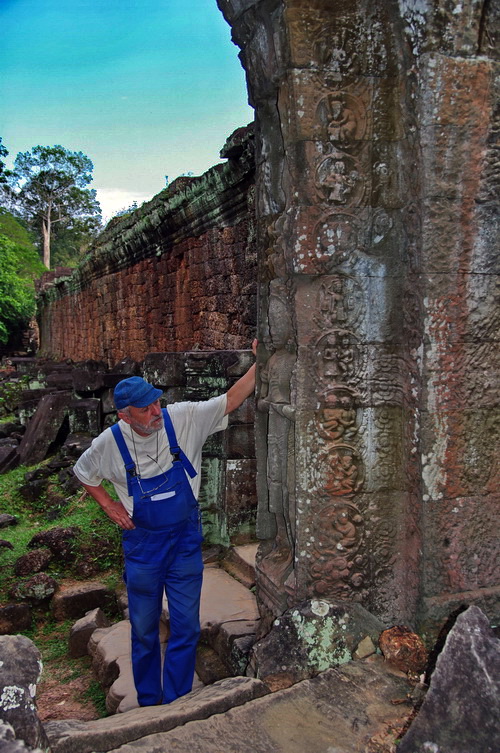
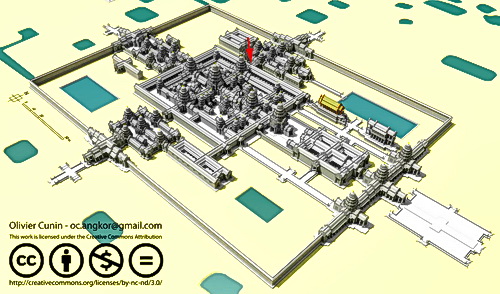
Classic Cambodian Legends
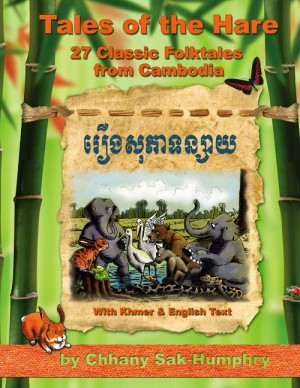
The Khmer people have always maintained a rich oral tradition of myths, legends and folklore. Technically, “myths” are fantastic tales of imagination while “legends” have some basis in real people, places and events…although the tales may become exaggerated or distorted over time (see this page for a comparison of these concepts).
In recent years, I’ve been working on a series of books relating folktales of Southeast Asia. The first in print, by Chhany Sak Humphry, is a bi-lingual (Khmer and English) collection, Tales of the Hare – 27 Classic Folktales of Cambodia.
In 2012, DatAsia Press will release scholar Solang Uk’s first English translation of G. H. Monod’s collection of Cambodian legends gathered in the early 20th century under the title “Women’s Wiles“. Also in final preparation is a collection of tales from Northeastern Thailand called, “The Naga Prince“, collected by Kermit Krueger while teaching in Mahasarakham in 1963.
The three collections include a wide range of characters and adventures. Some stories explain how great monuments like Angkor Wat were built. Others tell tales of kings and queens of old, magicians, lovers, pirates…and even a clever rabbit who tricks tigers, elephants, crocodiles and people!
With these ancient tales in mind, one day I found myself facing a mystery at Preah Khan.
Preah Khan’s Mystery Door of Legends
In 2008 while exploring Preah Khan I was intrigued to see, among the ruins, an intricately carved door frame with nine distinctive emblems. Each one seems to tell a story long since forgotten but, evidently when they were carved nearly 900 years ago, these stone images spoke quite clearly to passersby.
Picture it today…what if you saw a princess with seven dwarfs by her side? Or a wolf dressed as an old woman carrying a basket of treats? Or two children in the woods finding a house made of gingerbread? Or a wooden manikin of a boy with an extremely long nose? Would you know the stories that the images conveyed?
Here, in the ancient capital of Angkor, students and teachers who passed this doorway in the university of Preah Khan also undoubtedly recognized the tales and the lessons they imparted. But what stories do these icons represent?
Below the nine images are presented from top to bottom. Does each one tell an individual tale? Or are they all part of one story? I invite your help in solving the mysteries…
#1. The Devata and the Devotee
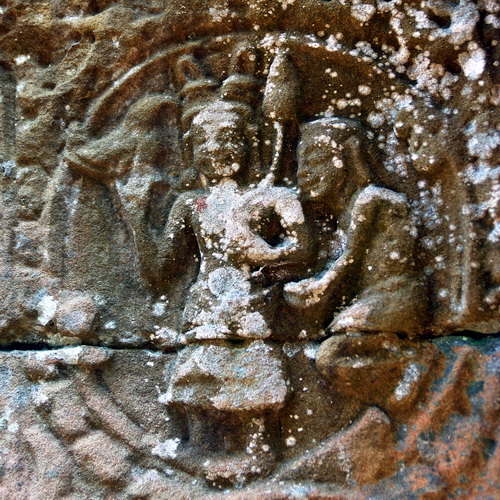
This young girl is clearly similar to many sacred devata (sacred women) who appear at Angkor Wat, Preah Khan, and every other major Khmer temple (see examples here or consult this master list of Khmer devata temples). As noted elsewhere on this site, the Khmer depicted many types of sacred women (see this article with helpful comments by Peter Sharrock and Robert McCarthy). Many of the distinctive, standing devata contain so much detail and such individuality that they appear to be portraits of specific living women. Again, Zhou Daguan confirms that thousands of women worked in the royal palace and participated in temple rituals as attendants and dancers.
Getting back to our happy subject, her unique double-looped hair style, the lotus she holds and a pet parrot all speak to her divine calling. French artist Jean Despujols painted this imaginary temple girl in 1936. The resemblance is striking and he was clearly inspired by Khmer art.
Meanwhile, back to our story, we see a man with a short hair cut and stretched earlobes kneeling at her side. Is he a devotee worshiping her…making an offering of food…or does he hope to become a lover?
#2. Walk Softly…and Carry a Big Stick
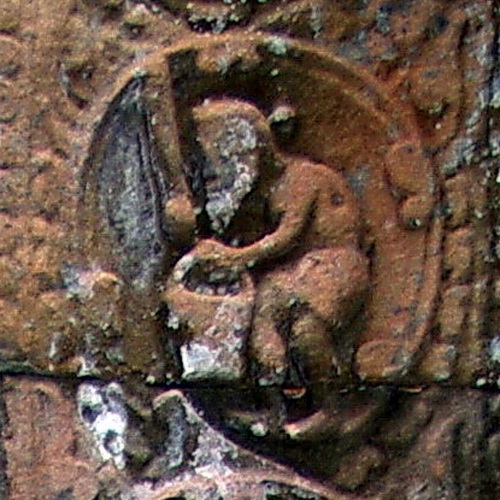
A stooped, bearded old man (a rishi?) carries a bucket in his left hand…and a thick club in his right. I’m not going to try to take his bucket away from him. Are you?
#3. Khmer Madonna with Child
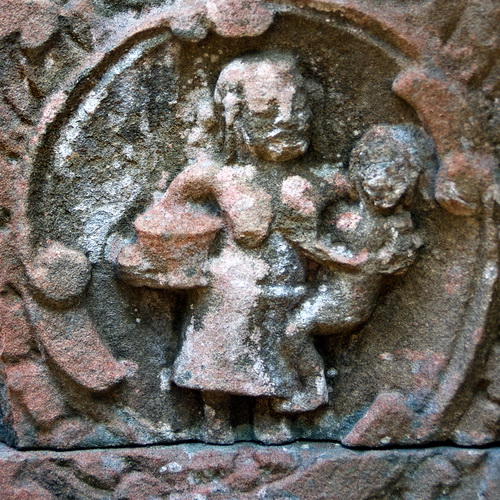
A mature, bare-breasted mother smiles widely as she carries a child, perhaps breast feeding him, along with a container possibly filled with rice. Her hair seems to be gathered in a clasp, falling in curls below. It is unfortunate that the child’s face can’t be seen. Is is possible that he is featured again in one of the icons below?
Like all the people depicted on this icons she is simply dressed like a peasant, as opposed to being of royal blood.
#4. The Naga Twins
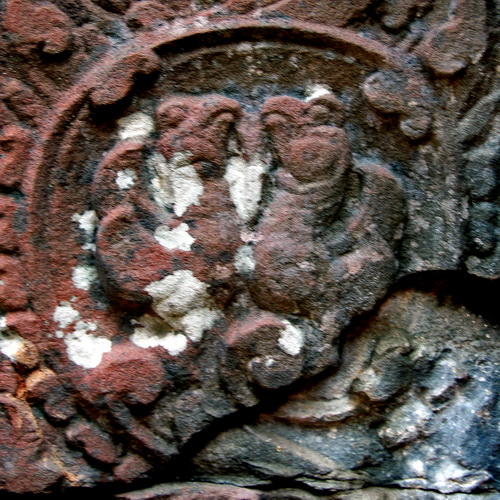
Two very happy snakes appear, but it’s logical to call them Naga in Khmer context. Kermit Krueger’s book, The Naga Prince, relates folktales of Northeastern Thailand, which is just north of Angkor…and the reputed birthplace of Khmer kings and relatives, including King Suryavarman II and King Jayavarman VII.
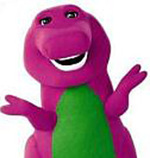
One tale, The Serpents and the Porcupine, tells of two huge serpents, Pinta-yonak-wati and Thana-moon, who fought for food in this region when it was covered with water before the beginning of time. Disturbed by their constant battles, the animals ask Indra himself to descend from heaven to stop their fighting. Long ago, the region was underwater, and other folktales also describe times when the geography was quite different from today. Could this tale have also been told in the Khmer capital in the 12th century?
But while I saw snakes, Olivier Cunin, saw birds. Indeed, double-wings are clearly visible on both sides and the bodies are somewhat “chicken-shaped.” But the heads and faces? Barney the Dinosaur (seen at left) instantly comes to mind. But perhaps those bulbous noses are actually big beaks that softened as the stone wore down.
But whatever this image represents, it’s quite whimsical and unique. To me, that implies there’s a story behind the happy faces.
#5. The Happy Water Girl
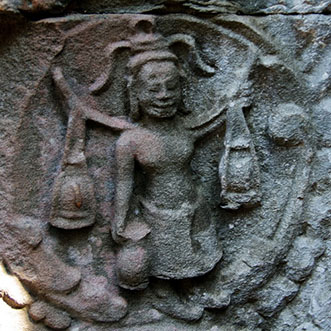
As in image #1, we again have a happy girl with a hairstyle reminiscent of Preah Khan devata (sacred females). Apart from that she appears quite ordinary and doesn’t seem to have any jewelry. She carries a jug while balancing two more containers on a yoke across her shoulders. I have noted a similar female appearing at the temple of Neak Pean offering water to a god.
#6. Beauty and the Beast?
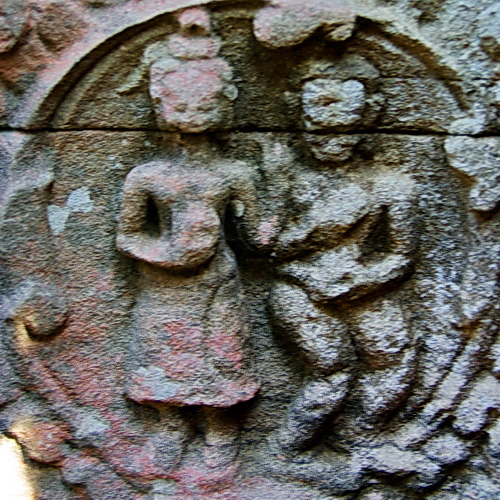
Here, a third attractive, devata-like girl appears with an unusual friend. Her left hand is raised, as if in benediction but it’s her right hand that is most puzzling. She seems to hold a large ring, which would be quite an anomaly! To my knowledge, the only women holding these mysterious necklace rings appear among the devata of Angkor Wat.
Dominique Soutif, head of EFEO in Siem Reap, presents an excellent argument that these icons may represent Rama’s ring, from the Ramayana story. In that context, the ring is also seen in bas relief carvings at the Baphuon, but as a ceremonial object held by women, I know of no other examples carved during the reign of Jayavarman VII…if that is what it represents.
Finally (and this was probably your first question) we must ask: Who is her stooped, devilish, and rather frightening, pointy-eared companion? A demon? She doesn’t seem scared. A warning? Of what? Or could it be Spock from the original *original* episode of Star Trek?
#7. The Demon Twins
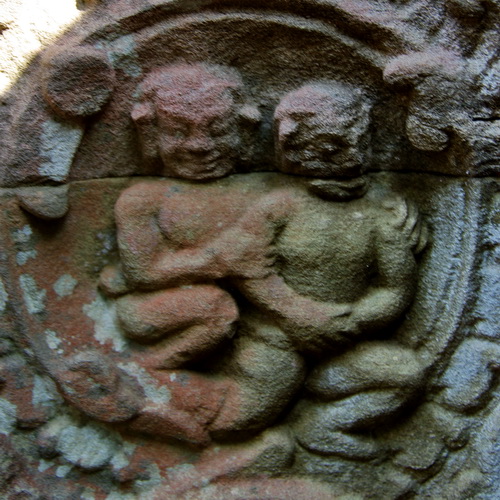
Here our tales take a turn to the macabre. The more charming character on the left has a semi-human appearance (perhaps he’s related to the pointy-eared fellow in #6 or could he even be the mother’s baby in #3?). But the creature on the right is much closer to being a monster than a man.
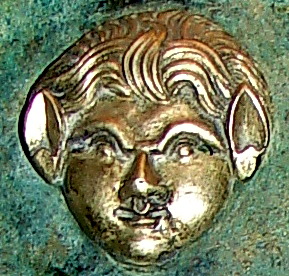
In an unusual twist, both seem to have small (but noticeable) horns or goat-like ears that don’t match other characters in Khmer tales. In Indian mythology,I only found one obscure goat-headed god (see this 1st century carving of Naigamesa).
Classical Greek mythology, however, has a whole menagerie of semi-human forest beings called satyrs and fauns — half-man, half-goat — who roamed the woods, played musical pipes, chased women and engaged in drunken revelry, no doubt due to the influence of their friend, Dionysus, the god of wine (also the god of ritual madness and ecstasy).
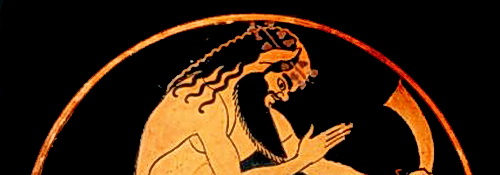
This mention of Greek mythology might seem entirely out of place except for what stands just a few hundred feet away from these icons: the only surviving example of a round columned temple that seems more Greek in character than Khmer.
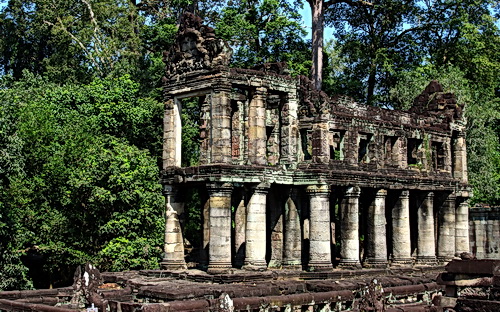
#8. A Close Encounter
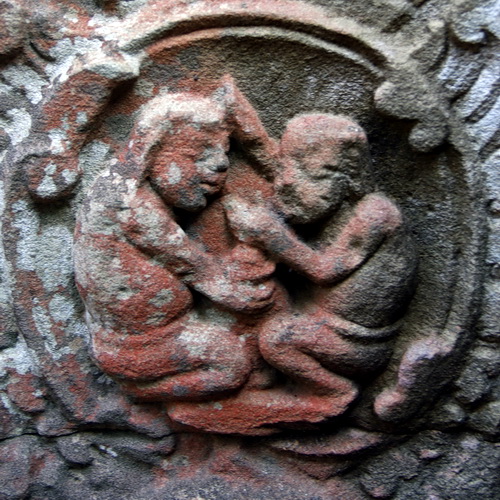
What is this intimate exchange between two people? Could it be a doctor and patient? Two lovers? A priest exorcising a demon from one possessed? Ordainment as a monk? A graduation or promotion? A bequest of a royal title?
Hard to say. The plump, kneeling figure on the left either has long hair or a cloth draped on the head. The right crouching figure touches the head while holding a hand close to the subject’s face. Could it be a lantern? An incense container? Medicine? Meanwhile, the figure on the left holds a bowl of some type. An offering? Rice? A hot fudge sundae?
Something significant is happening here…but what?
#9. The Two Brothers
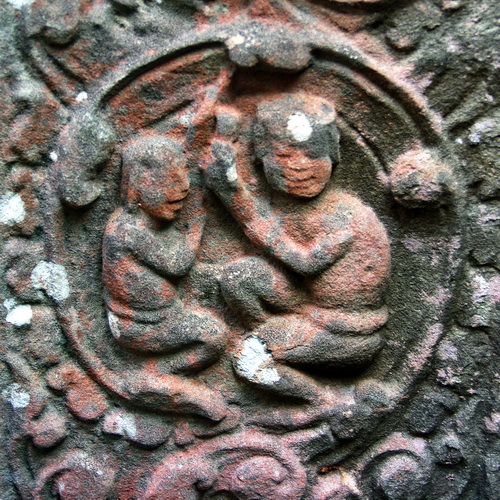
This final image is yet another inexplicable interaction between two happy people: older and younger siblings? A student and teacher? A child and parent? Interpretations remain elusive. Both noticeably well-fed figures kneel, each raising joined hands. The figure on the right holds an object, perhaps a palm leaf book? Could this final image show a graduation? And what connection, if any, exists with the preceding images above?
Is this just “artistic freedom” in Angkor?
Let’s pause for a moment to consider the setting for this art. Preah Khan was a royally sanctioned temple, a monument to a great Khmer military victory, an active site of worship and sacred ritual, and an institution of learning.
Some casual observers are quick to assume that artists just added images arbitrarily “for artist flair”. I think this view is almost always wrong, especially in the context of these monuments. The Khmer were architectural and artistic geniuses who were masters of planning and design. My view is that it is always more logical to begin with the theory that illustrations, even small ones, may hold significance.
The most comprehensive first-person account of the Khmer Empire by Zhou Daguan supports this theory. As he describes, laws dictated how citizens of Angkor could dress, act and even how they built their homes. It seems incredibly naive to assume that artists had “creative freedom” to carve what they wanted in these sacred temples. Maybe it happened sometimes, but isn’t it more logical to seek meaning in these illustrations, such as the Preah Khan doorway images above?
Decorative medallions like these are popular throughout Khmer temples. While there are almost no written records of the Khmer they did create exceptionally detailed bas reliefs to convey great literary works (e.g. Angkor Wat) and to record historical and royal events, as well as scenes from everyday life (e.g. the Bayon, Banteay Chhmar). As the photo below shows, these images can be quite serious and realistic.
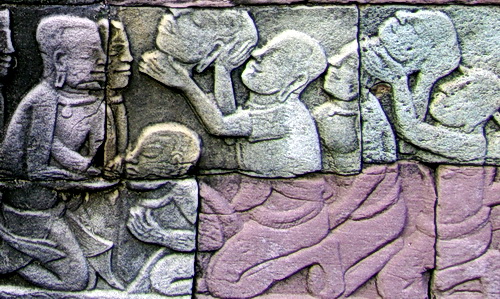
Or could it be “Aesop in Angkor”?
With the serious illustration above in mind let us reconsider the door frame icons. Their lack of artistic sophistication implies that they don’t tell great tales of history or complex Buddhist, Hindu or royal ideology. No, these smiling figures are entertaining, playful…and even a bit comical.
Which brings to mind Aesop’s fables, attributed to a story teller who supposedly lived about 1,800 years before Preah Khan was built.
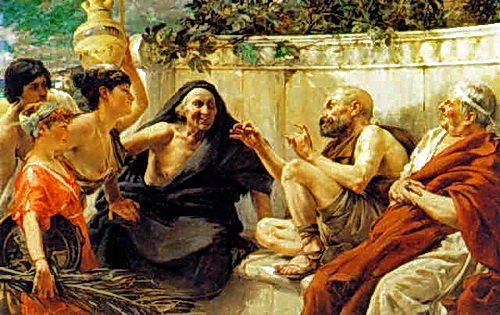
Unlike the lost legends of Preah Khan, Aesop’s fables have been told, retold, translated and published countless times. Most of Aesop’s tales include intelligent animals, exactly like Cambodia’s Tales of the Hare, while others mix people into the action. To read some of them there’s no better place than AesopFables.com.
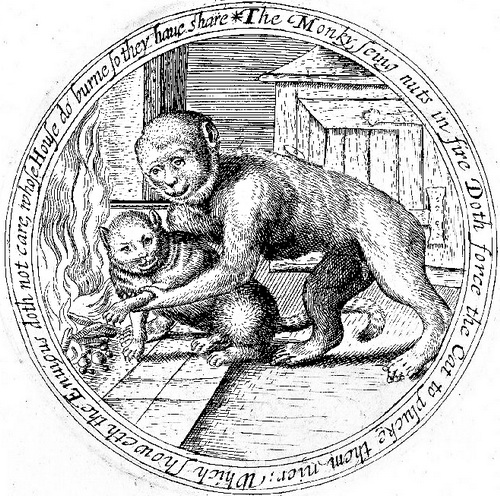
The question that I begin to ask is: What if the designs were meant for children? Could the pillar have stood at the entrance to an elementary or nursery school area of the temple?
The Khmer people, then and now, are quick to smile and enjoy a good tale. They love their children and still entertain and educate youngsters with parables and legends. Of cource universities around the world still do this today. I particularly enjoy this photo of Dr. Seuss Day at the University of Wisconsin’s child care center.
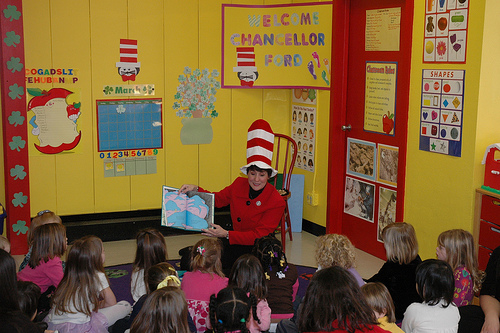
Could the Khmer have included children’s tales in their splendid architecture? Visitors to the Tribune Tower in Chicago, Illinois would be quick to confirm that “serious buildings” can include imaginative art. In 1925 the classically trained sculptor, Rene Paul Chambellan, created an entrance with ancient children’s fables in mind. As a parting thought please see Jyoti’s article Tribune Tower : Hall of Inscriptions and Aesop’s Stone Screen.
And then join the mystery. What are your ideas about the mystery door at Preah Khan?
Preah Khan Site Plan Showing Door of Legends
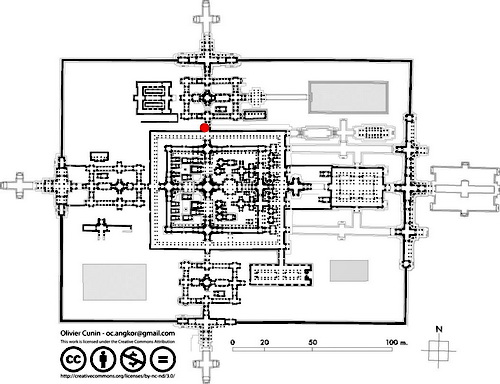
Post Script: The Stegosaurus of Ta Prohm
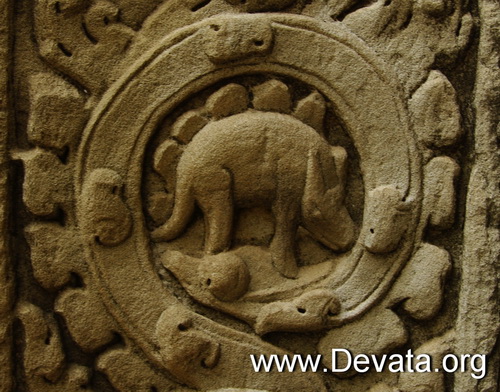
One Khmer image that has inspired quite lively debate is in the temple of Ta Prohm, also built by King Jayaraman VII and Queen Indradevi.
I don’t know much about dinosaurs but, if I were to draw a stegosaurus, it would look a lot like the ancient Khmer version. I may have even added “triceratops” horns, as above. By the way, in 2010 paleontologists gave misguided “triceratops” fans like me some very bad news by announcing that the triceratops never existed. In fact it was just a juvenile version of the Torosaurus.
That said, the carving still reminds me of dino toys, like these from Toy Essentials…
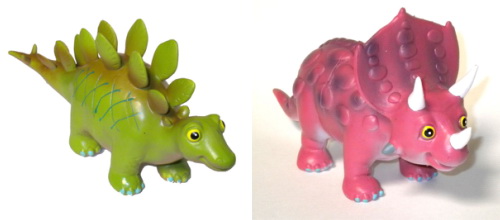
The implication some draw from this icon is that humans and dinosaurs co-existed (i.e. that the artist carved a dinosaur because he or she saw one). Christian creationists, therefore, love this icon. Other suggest that it is a boar, rhino, hippo, dog…or “the artist’s imagination.” The most absurd theory, instantly proven false by visiting the site, is that the carving was added recently. It’s clear that this image was contemporary with the other complex carvings around it.
The Smithsonian Magazine, Steosaurus, Rhinoceros, of Hoax?, does a good job presenting all sides to the story. For creationist viewpoints (which have great photos, info and debate) visit Bible.ca or The GeeChristian,
But let’s forget about dinosaurs for now. Nine other mysteries at Preah Khan are waiting to be solved!
By Kent Davis for Devata.org
